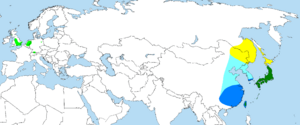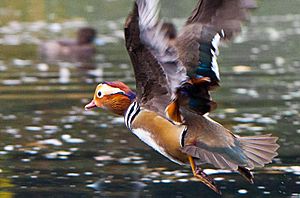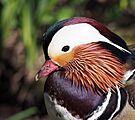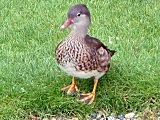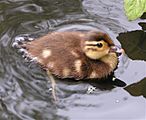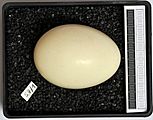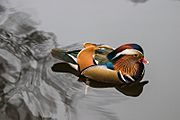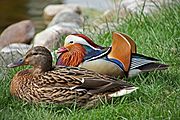Mandarin duck facts for kids
Quick facts for kids Mandarin Duck |
|
|---|---|
 |
|
| A pair of ducks in Switzerland | |
| Conservation status | |
| Scientific classification | |
| Kingdom: | |
| Class: | |
| Order: | |
| Family: | |
| Genus: |
Aix
|
| Binomial name | |
| Aix galericulata (Linnaeus, 1758)
|
|
The mandarin duck (Aix galericulata) is a beautiful bird. It lives in eastern Siberia, China, and Japan. These ducks spend their winters in warmer parts of southern China and Japan. You can also find a small group of mandarin ducks living freely in Britain. These ducks came from birds that were once kept in captivity and then released.
Contents
What Does a Mandarin Duck Look Like?
The male mandarin duck is very colorful. He has a red beak and a large white stripe above his eye. His face is reddish with "whiskers" of feathers. The male's chest is purple with two white stripes. His sides are reddish, and he has two orange "sails" on his back. These are large feathers that stick up like boat sails.
The female mandarin duck is less colorful. She looks a bit like a female wood duck. She has a white ring around her eye and a stripe going back from her eye. Her belly is lighter in color. She also has a small white stripe on her side and a light tip on her beak.
Both male and female mandarin ducks have crests on their heads. The male's purple crest is much bigger and easier to see.
Changing Feathers: Eclipse Plumage
Like many other ducks, the male mandarin duck changes his feathers after the mating season. This is called a moult. During this time, he gets what is called "eclipse plumage." When he is in eclipse plumage, the male looks more like the female. However, you can still tell him apart. He will have a bright yellow-orange or red beak. He also won't have his big crest, and his eye-stripe will be less noticeable.
Baby Mandarin Ducks
Baby mandarin ducks, called ducklings, look very much like baby wood ducks. They are also quite similar to mallard ducklings. You can tell mandarin ducklings apart from mallard ducklings by looking at their eye-stripe. The eye-stripe on a mandarin duckling stops at the eye. On a mallard duckling, it goes all the way to the beak.
Different Colors: Mutations
Sometimes, you might see mandarin ducks that are a different color. The most common is the white mandarin duck. These special ducks are usually found in places where ducks are kept by people. Scientists believe this color change happened because of careful breeding over time.
Where Do Mandarin Ducks Live?
Mandarin ducks used to be found all over East Asia. But because people cut down their forest habitat and exported many ducks, their numbers have dropped. In eastern Russia and China, there are now fewer than 1,000 pairs. Japan still has about 5,000 pairs. The ducks in Asia migrate. This means they fly to warmer areas like lowland eastern China and southern Japan for the winter.
Many mandarin ducks have escaped from collections around the world. In the 1900s, a large group of wild mandarin ducks started living in Great Britain. Smaller groups have also begun to breed in Ireland, especially in parks in Dublin. Today, there are about 7,000 mandarin ducks in Britain. Other groups live in Europe, with the largest one near Berlin. You can even find small groups in the United States. For example, there's a small group in Black Mountain, North Carolina. In Sonoma County, California, hundreds of mandarin ducks live freely. These ducks started from a few that escaped and then had babies in the wild.
Mandarin ducks like to live near rivers and lakes that have thick forests around them. They usually live in low areas. However, they can breed in valleys up to 1,500 m (4,900 ft) high. In winter, they also live in marshes, flooded fields, and open rivers. While they prefer fresh water, they might spend winter in coastal lagoons too. In Europe, where they were introduced, they live in more open areas. These include lake edges, wet meadows, and farms with nearby woods.
Mandarin Duck Behavior
Reproduction and Life Cycle
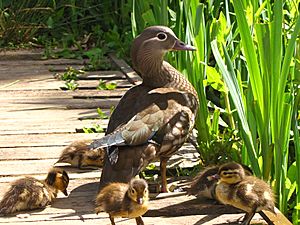
In the wild, mandarin ducks make their nests in thick forests near shallow lakes or ponds. They build their nests inside holes in trees that are close to water. In spring, usually April or May, the female lays her eggs in the tree cavity after mating. She lays one group of about nine to twelve eggs. The male duck might protect the female and the eggs while she sits on them. But he does not sit on the eggs himself. He leaves before the ducklings hatch.
Soon after the ducklings hatch, their mother flies down to the ground. She then calls to her babies, encouraging them to jump out of the nest. Once all the ducklings are out of the tree, they follow their mother to a nearby body of water.
What Do Mandarin Ducks Eat?
Mandarin ducks find their food by dabbling in water or walking on land. They mostly eat plants and seeds. They especially like beech nuts. These ducks also eat snails, insects, and small fish.
Their diet changes with the seasons. In fall and winter, they mainly eat acorns and grains. In spring, they eat more insects, snails, fish, and water plants. During the summer, they enjoy eating dew worms, small fish, frogs, mollusks, and small snakes. They usually feed early in the morning or late in the evening. During the day, they rest in trees or on the ground.
Threats to Mandarin Ducks
Many different animals hunt mandarin ducks depending on where they live. Some predators include Mink, raccoon dogs, otters, polecats, Eurasian eagle owls, and grass snakes.
The biggest danger to mandarin ducks is the loss of their homes. This happens when people cut down forests. Hunters can also be a threat. Sometimes, hunters accidentally shoot mandarin ducks because they don't recognize them in flight. Mandarin ducks are not usually hunted for food. However, they are sometimes illegally hunted because their beautiful feathers are highly valued.
Mandarin Ducks in Culture
Chinese Culture
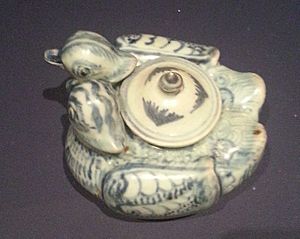
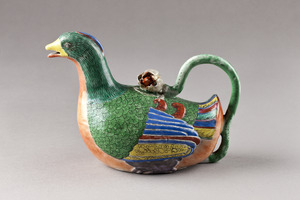
In China, mandarin ducks are called yuanyang (simplified Chinese: 鸳鸯; traditional Chinese: 鴛鴦; pinyin: yuān yāng). The word yuan (Chinese: 鴛) means the male duck, and yang (Chinese: 鴦) means the female. In traditional Chinese culture, people believe that mandarin ducks stay together for their whole lives. Because of this, they are a symbol of love and loyalty between couples. You can often see them in Chinese art.
There is a Chinese saying for loving couples: "Two mandarin ducks playing in water" (simplified Chinese: 鸳鸯戏水; traditional Chinese: 鴛鴦戲水; pinyin: yuānyāng xì shuǐ). A mandarin duck symbol is also used in Chinese weddings. This is because they represent a happy marriage and faithfulness.
Because the male and female mandarin ducks look so different, the word yuan-yang is also used in Cantonese to mean an "odd couple" or an "unlikely pair." This refers to mixing two different types of the same thing. For example, there is a drink called yuanyang and a dish called yuan-yang fried rice. Mandarin ducks were even shown on the flag of Weihaiwei when it was under British rule.
Korean Culture
For Koreans, mandarin ducks mean peace, loyalty, and having many children. Like the Chinese, Koreans believe these ducks stay together for life. Because of this, pairs of mandarin ducks, called wedding ducks, are often given as wedding gifts. They are a very important part of Korean marriage traditions.
Japanese Culture
In Japanese, these ducks are called oshidori (おしどり/オシドリ/鴛鴦). This word is used in the phrase oshidori fūfu (おしどり夫婦, "a couple of lovebirds/happily married couple"). This phrase describes a couple who are very much in love and happily married.
Gallery
-
Drake in eclipse plumage
Images for kids
-
A male mandarin duck in Central Park, New York
See also
 In Spanish: Pato mandarín para niños
In Spanish: Pato mandarín para niños



